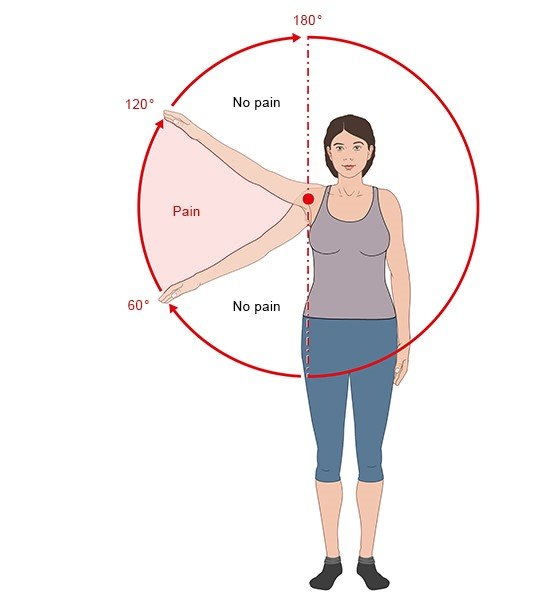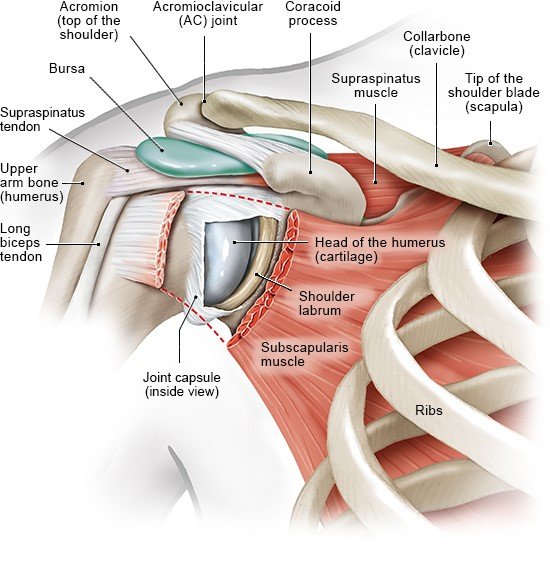Deutsche Vereinigung für Schulter- und Ellenbogenchirugie (DVSE), Deutsche Gesellschaft für Orthopädie und Unfallchirurgie (DGOU). Subacromiales Impingement (S2e-Leitlinie) AWMF-Registernr.: 087-060. 2021.
Diercks R, Bron C, Dorrestijn O et al. Guideline for diagnosis and treatment of subacromial pain syndrome: a multidisciplinary review by the Dutch Orthopaedic Association. Acta Orthop 2014; 85(3): 314-322.
Garving C, Jakob S, Bauer I et al. Impingement Syndrome of the Shoulder. Dtsch Arztebl Int 2017; 114(45): 765-776.
Gill TK, Shanahan EM, Allison D et al. Prevalence of abnormalities on shoulder MRI in symptomatic and asymptomatic older adults. Int J Rheum Dis 2014; 17(8): 863-871.
Gray M, Wallace A, Aldridge S. Assessment of shoulder pain for non-specialists. BMJ 2016; 355: i5783.
Karjalainen TV, Jain NB, Page CM et al. Subacromial decompression surgery for rotator cuff disease. Cochrane Database Syst Rev 2019; (1): CD005619.
Kulkarni R, Gibson J, Brownson P et al. Subacromial shoulder pain. Shoulder Elbow 2015; 7(2): 135-143.
Lähdeoja T, Karjalainen T, Jokihaara J et al. Subacromial decompression surgery for adults with shoulder pain: a systematic review with meta-analysis. Br J Sports Med 2020; 54(11): 665-673.
Liaghat B, Ussing A, Petersen BH et al. Supervised Training Compared With No Training or Self-training in Patients With Subacromial Pain Syndrome: A Systematic Review and Meta-analysis. Arch Phys Med Rehabil 2021; 102(12): 2428-2441.
Liu TC, Leung N, Edwards L et al. Patients Older Than 40 Years With Unilateral Occupational Claims for New Shoulder and Knee Symptoms Have Bilateral MRI Changes. Clin Orthop Relat Res 2017; 475(10): 2360-2365.
Steuri R, Sattelmayer M, Elsig S et al. Effectiveness of conservative interventions including exercise, manual therapy and medical management in adults with shoulder impingement: a systematic review and meta-analysis of RCTs. Br J Sports Med 2017; 51(18): 1340-1347.
Tran G, Cowling P, Smith T et al. What Imaging-Detected Pathologies Are Associated With Shoulder Symptoms and Their Persistence? A Systematic Literature Review. Arthritis Care Res (Hoboken) 2018; 70(8): 1169-1184.
Vandvik PO, Lähdeoja T, Ardern C et al. Subacromial decompression surgery for adults with shoulder pain: a clinical practice guideline. BMJ 2019; 364: i294.
IQWiG health information is written with the aim of helping people understand the advantages and disadvantages of the main treatment options and health care services.
Because IQWiG is a German institute, some of the information provided here is specific to the German health care system. The suitability of any of the described options in an individual case can be determined by talking to a doctor. informedhealth.org can provide support for talks with doctors and other medical professionals, but cannot replace them. We do not offer individual consultations.
Our information is based on the results of good-quality studies. It is written by a team of health care professionals, scientists and editors, and reviewed by external experts. You can find a detailed description of how our health information is produced and updated in our methods.



